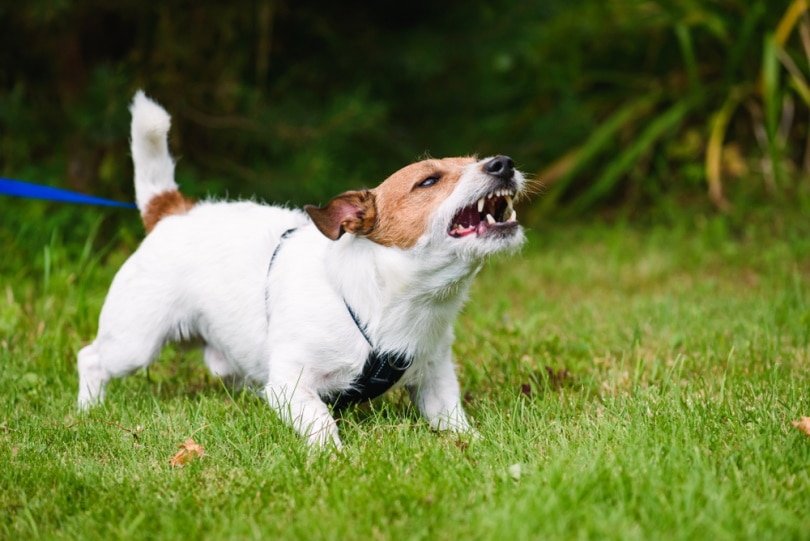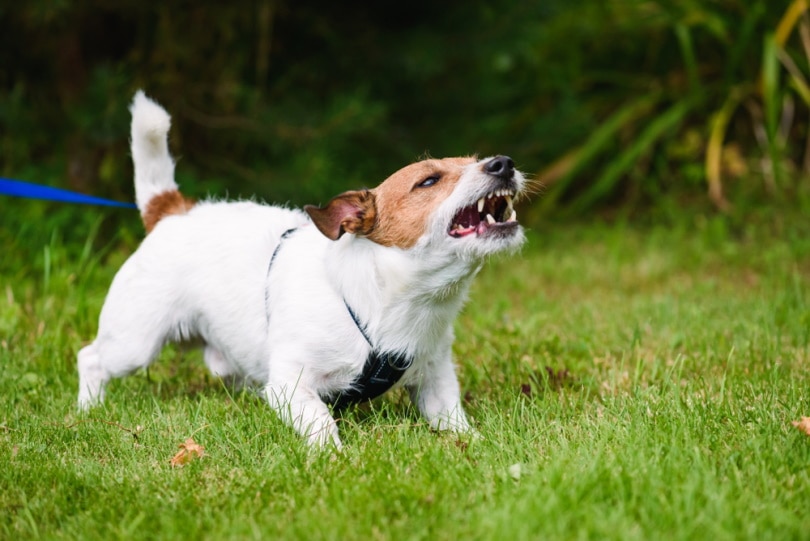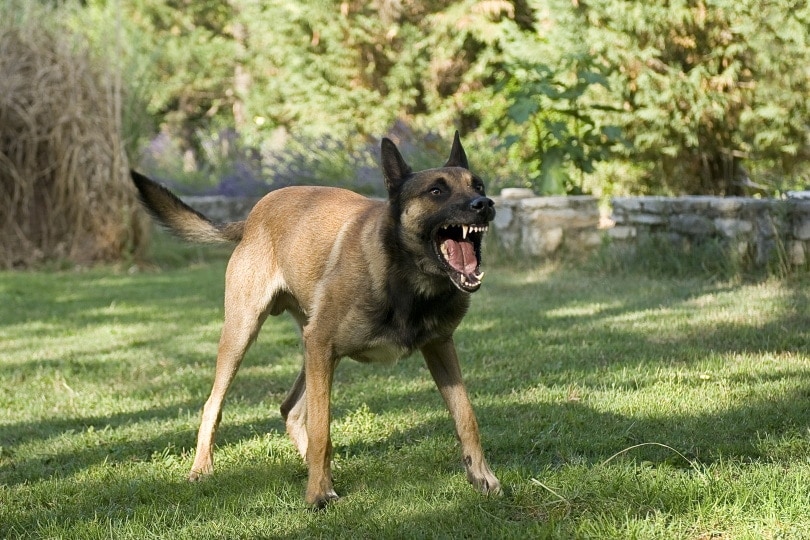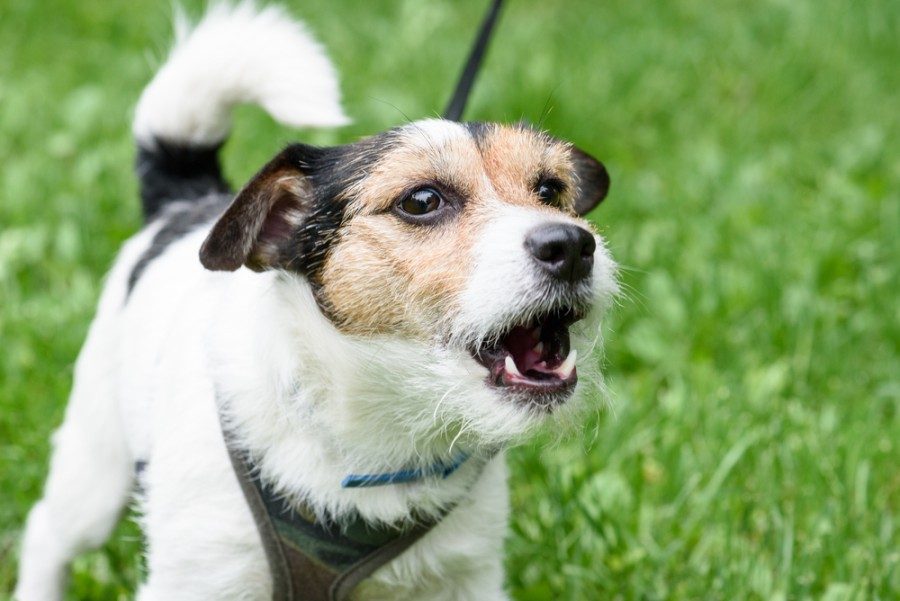- March 16, 2024
Why Does My Dog’s Hair Stand Up When Barking? 5 Vet-Reviewed Reasons



The information is current and up-to-date in accordance with the latest veterinarian research.
You might notice your dog with raised hair on their back on many occasions. This is an entirely normal reaction called piloerection, and it usually happens when your dog feels angry or scared. It is most likely followed by barking and other aggressive behavior and indicates your dog feels threatened. When this occurs, it is recommended to remove your dog from the situation, which makes them feel anxious.
If you are wondering what other reasons might be behind your dog barking and having raised hairs on their back, read on below.

What is Piloerection?
Piloerection is a term used to describe a temporary rising of the hairs that cover the skin’s surface. It is an involuntary contraction of the muscles that are located on the base of hair follicles. When these muscles contract, the hairs stand on end, like when humans get goosebumps. This can happen in cold weather, with the raised fur creating an insulating layer of air around the body to reduce heat loss. It also helps animals appear larger than they are.
In dogs, these hairs are referred to as hackles, and are located on the neck, running down the dog’s back all the way to the base of the tail.
While every dog has these hackles, they are more obvious in some breeds than others; dogs with curly or long hair don’t show piloerection very clearly, while it is quite obvious in dogs with short coats. Piloerection only lasts a few seconds, making it challenging to photograph and sometimes even observe. This reaction occurs mostly when dogs feel aggressive, scared, or agitated in some way, and below, we’ll go over the most common reasons for piloerection to occur in dogs.


The 5 Reasons the Dog’s Hair Stands Up When Barking
1. Excitement
Excitement is a very common trigger of piloerection. You might notice the hairs on your dog’s back rising during playtime with another dog or with you. Piloerection is not always a negative thing and might just indicate your dog is extremely stimulated or excited. It will usually appear combined with some happy tail wagging, panting, and barking. Your dog may be excited to see you or a friend or might be getting a treat. They will start barking, and sometimes, you can notice their hackles rising.
2. Fear or Anxiety
Another extremely important reason for raised hackles in dogs while barking is fear. Fear of the unknown or feeling threatened by something is a very strong trigger for piloerection. This usually happens when they encounter another dog, making them feel intimidated. These anxious or fearful reactions might also occur during thunderstorms or other loud noises that scare your dog. Dogs are often scared of loud noises, particularly fireworks, strong wind, or storms. During these events, you may catch them trembling, panting, barking, licking lips, yawning, and having their hackles rise.

3. To Assert Dominance
Dogs sometimes show raised hackles when they want to establish dominance over another dog. It can happen between dogs that are related or live together, or with dogs that are meeting for the first time. Raising their hackles makes them appear larger, and also communicates to the other dog that they wish to exert dominance or issue a challenge.
4. Anger and Aggression
The situation when you can most clearly notice your dog’s hair rising on its back is when it feels aggressive, hostile, or intimidated. This usually occurs when another dog or animal is stepping into their territory, and it’s a natural reaction to warn other dogs to stay away. The dog might start barking suddenly, and you will surely notice the hairs on their back rising. Other signs of aggression might appear as well.
5. Mating
The state of arousal is another common reason dogs experience piloerection. This phenomenon especially occurs in unneutered male dogs when they are around a female. If there are two potential males for mating around one female, the dogs might feel both aggression and arousal. Male dogs are generally quite difficult to handle around a female dog in heat, so if they start barking and raise their hackles, they are most likely feeling aroused and might even sense another male nearby.


Conclusion
Once you learn the different situations when your dog might bark and experience piloerection simultaneously, you will get a much better perspective of their behavior. This entirely natural reaction allows animals to appear larger for other animals they feel threatened by. Dogs often feel threatened by other dogs or strange people and might feel anger or fear when they enter their territory.
This is usually why dogs bark at people passing by their backyard and why the hairs on their backs might rise. Dogs are also scared of loud noises, such as fireworks or thunder, so they might also experience piloerection during these situations.
Featured Image Credit: alexei_tm, Shutterstock
Tags
What do you think?
Related Articles

New Puppy Checklist: Gear You’ll Need for Your New Dog
Getting a new puppy is really exciting, but before you welcome them home, it’s important to prepare your space for them. Since puppies need a

How Big Do Mini Poodles Get? Vet Reviewed Average Weight & Growth Chart – Dogster
The information is current and up-to-date in accordance with the latest veterinarian research. Learn more » When you buy a Miniature Poodle, you might not

Can Police Dogs Smell Nicotine? Vet Verified Facts & Info – Dogster
The information is current and up-to-date in accordance with the latest veterinarian research. Learn more » While cigarette sales have been declining steadily for decades,

How Old Is 5 in Dog Years? Vet-Approved Guide to Each Size of Dog – Dogster
The information is current and up-to-date in accordance with the latest veterinarian research. Learn more » A common method for calculating a dog’s age is

